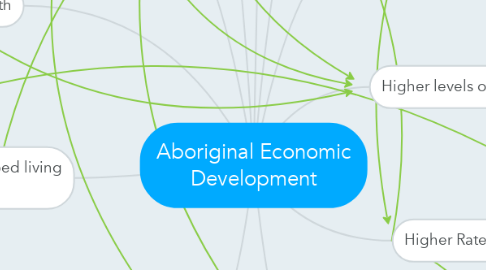Aboriginal Economic Development
by Heather Dufault

1. Lower Income Levels
1.1. The median income for Aboriginal peoples was $20,701, whereas the median income for non-Aboriginal people was $30,195
1.2. The earning gap between Aboriginal workers and non-Aboriginal workers shrank between 1996 and 2006. According to The Income Gap Between Aboriginal Peoples and the Rest of Canada, if the gap continued to close at the current rate it would take 63 years for it to be erased
2. Deficient housing and cramped living circumstances
2.1. Aboriginals often have big families living in smaller homes that cannot accommodate the family very well
2.2. They cannot expand, renovate or move due to financial matters
2.3. Rate of overcrowding among First Nations households compared to those in the rest of Canada is 2 times
3. Poorer health
3.1. Chronic diseases such as diabetes and heart disease are on the increase
3.2. There is a higher rate of respiratory problems and other infectious diseases among Aboriginal children than among non-Aboriginal children (inadequate housing and crowded living conditions are contributing factors)
4. Violence and Substance Abuse
4.1. The risk of victimization of Aboriginal people remained 58% higher than that of non-aboriginal people
4.2. Aboriginals adults are incarcerated 3x to 5x higher compared to Non-Aboriginals
5. Poverty
5.1. 1 in 4 children in First Nation families are living in poverty
5.2. Aboriginals who reported being hungry due to lack of money for food is about 17.8%
6. Higher rates of suicide
6.1. A 2016 Statistics Canada report found that more than one in five off-reserve First Nations, Métis and Inuit adults reported having suicidal thoughts at some point in their lives
6.2. Suicide rates are five to seven times higher for First Nations youth than for non-Aboriginal youth, and for Inuit youth, the rate is among the highest in the world - 11 times the national average
7. Higher death rate amongst children and youth due unintentional injuries
7.1. According to Health Canada statistics, Aboriginal children are three to four times more likely to die from unintentional injury than non-Aboriginal children of the same age
8. Higher levels of incarceration
8.1. Aboriginal women represent 34.5 per cent of all women in prison, while aboriginal men represent 22.6 per cent of male prisoners
8.2. The proportion of the prison population of Aboriginal background increased to 20.9 per cent between 2009-10 and 2013-14, rising from 4,019 to 4,860
9. Higher Rates of Unemployment
9.1. The unemployment rate for the Aboriginal working-age population is 15% which is double the 7.5% rate for the non-Aboriginal individuals
9.2. They may not be able to find jobs due to the options available in their area
10. Lower education levels
10.1. 22.8% of Aboriginal Peoples had completed high school and post secondary education (according to 2011 Canadian Aboriginal Survey)
10.2. Colonialism accounts for many bitter, demoralizing legacies, the most pervasive of which is education - the root of this particular legacy is that ultimate national experiment in assimilation (Known as Residential Schools)
11. Inequality
11.1. Canadian Aboriginals are more likely to experience unemployment
11.2. Aboriginals have a lower median after-tax income


